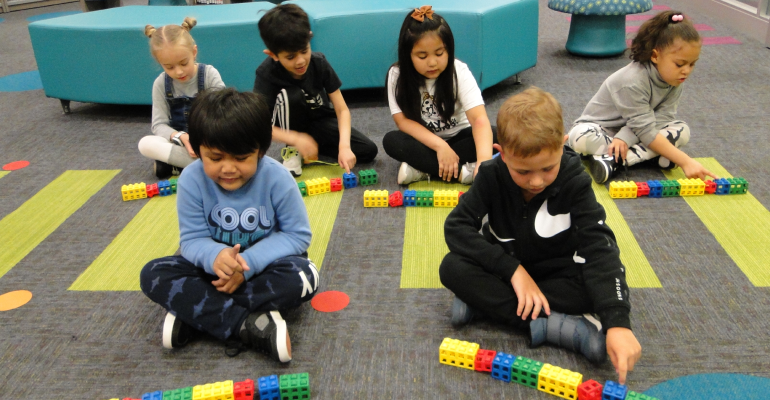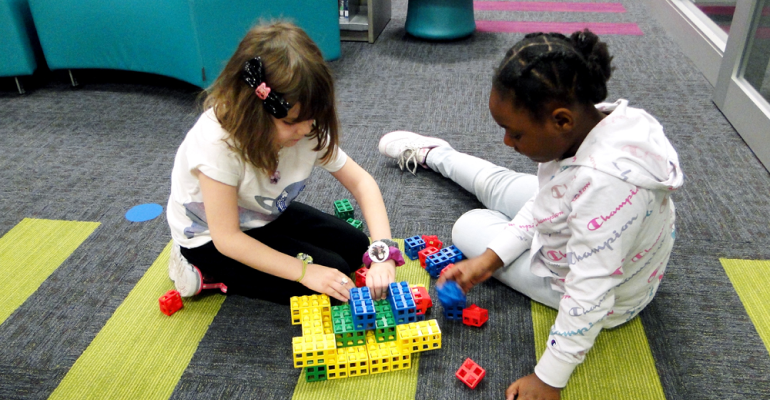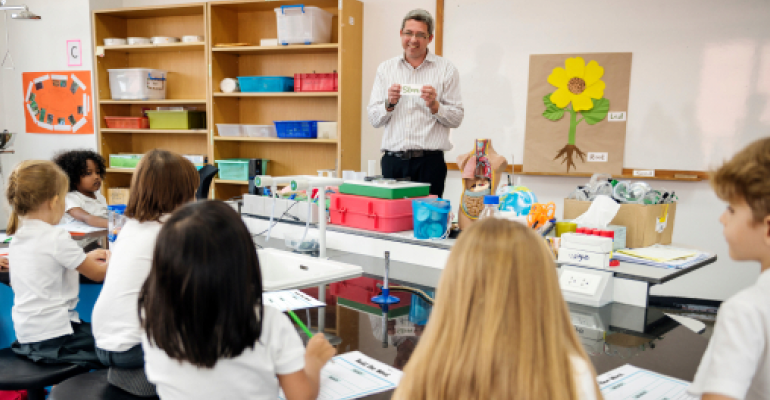
The classroom provides a safe space to explore STEM concepts and build STEM identity. Here’s a guide on how to bring STEM to your classroom.
While there are many things to celebrate in the latest advancements in STEM education, STEM is still as important as ever in our classrooms. It’s here that students grow their confidence in STEM, develop their STEM identity, and look up to confident STEM mentors in the safe space of their familiar classroom.
In 2023, the lack of gender and racial parity in STEM professionals is still apparent. Students of color receive fewer degrees in STEM fields compared to their comparative representation in the population, and women still earn very few degrees in fields such as Computer Science or Engineering (International Journal of STEM Education). These gaps in higher education can be solved in early education with regular exposure to STEM subjects and the space to cultivate curiosity around STEM in the classroom.
At Kid Spark Education, we’re on a mission to close the gap in the inequities of STEM education and build a future in the world of STEM that looks as diverse as the world we live in.

That’s why offering students regular interactions to engage in STEM activities in the classroom is so important, so we’re here to support educators and STEM mentors by creating helpful resources like this one to give you all the tools you need to bring STEM to your class.
In this article, you’ll find:
- How to Incorporate STEM into the Classroom
- STEM Activities for Classrooms
- Resources for Educators for STEM Instruction
Follow along to learn more, or reach out to the Kid Spark team to plan your STEM program.
STEM for Classrooms in 2023
The fields of STEM change nearly every day, fueling true innovation around the world. STEM instruction changes rapidly, too. The students of today are surrounded by new technologies and scientific discoveries brought directly to them through the prevalence of digital media.
To keep students inspired and engaged in their STEM education, their instruction needs to introduce them to the inner workings of the technologies around them and the continual process of innovation in our modern world.
STEM for classrooms in the modern era should include a blend of foundational STEM fluencies and exciting new technologies that students can experiment with, explore, and manipulate. At Kid Spark Education, we believe in starting these foundational fluencies early at Pre-K and providing a cumulative curriculum that gradually introduces new STEM concepts that build upon their previous STEM knowledge. (You can learn more about our comprehensive STEM programs, here.)
How to Incorporate STEM in the Classroom
STEM education thrives in diverse integration and exposure. That means incorporating a blend of STEM activities, STEM kits, and STEM challenges into the classroom.
There are also certain considerations for STEM activities for classrooms. These include complying with current curriculum and district or board input, instruction based on Next Generation Science Standards, and including activities that build both convergent and divergent learning.
Here are a few ways to incorporate STEM in the classroom and educational considerations for each.
STEM Activities for Classrooms
STEM activities are structured projects that allow students to practice and explore new STEM concepts. These activities can exist as singular classroom projects or as a part of a lesson plan or structured curriculum.
To find STEM activities for the classroom, you can incorporate a comprehensive STEM program like Kid Spark’s, or find singular STEM activities through online educational resources for teachers such as NASA, PBS, or the National Science Teaching Association among others.

A Convergent and Divergent Approach to STEM Activities
The STEM activities included in Kid Spark lesson plans include both convergent and divergent learning for students. This means that students explore STEM concepts dimensionally: understanding how a new STEM concept solves a problem, then exploring different ways to apply that new concept through their own experimentation.
With this type of instruction, students learn both how and why things work the way they do, and how to combine their STEM knowledge to analyze new challenges and find their own creative solutions through critical thinking and experimentation.
STEM Kits Designed for the Classroom
STEM kits also vary in design and implementation, but typically provide not only instructions for STEM activities and lesson plans, but the tools and materials to complete the activity as well.
While there are many different types of educational STEM kits, choosing a STEM kit designed for the classroom typically provides the most opportunity for your students and the most support for you.
An All-in-One STEM Kit for the Classroom
When we set out to close the equity gap in STEM education, we wanted to create a comprehensive program that met the diverse needs of students and educators and provided all the tools and resources they needed to succeed. That’s why our STEM programs include:
- Curriculum Tools: student worksheets, unit assessments, printed instructions for each STEM activity, and reading materials for students.
- Instructional Tools: instruction guides for educators on how to lead STEM activities, unit assessment keys, complete lesson plans, and online educator resources for teachers.
- STEM Activities: each comprehensive STEM kit includes multiple hands-on learning activities and lesson plans with all the needed materials included.
- Reusable Materials: every component that is needed for STEM activities or challenges in a Kid Spark STEM kit is included. This includes all engineering and building components, robotic elements and controllers, 3D printing materials, and more. There’s no additional cost or burden placed on the school or the teacher to supply materials for hands-on learning activities.
- Professional Learning Resources for Educators: empowered STEM mentors inspire students. That’s why we provide a robust online library of professional development courses just for teachers.
- STEM Challenges: in addition to the STEM activities included in each lesson plan, our STEM kits include creative challenges for students to explore concepts further while still using the same components and materials provided in each kit.
- Comprehensive Curriculum Support: Kid Spark STEM kits are designed for students Pre-K through Grade 8 within a progressive curriculum that builds on concepts from previous Kid Spark lessons. To assist educators and administrators in bringing an all-in-one STEM program across grade levels, we work with you to understand your curriculum needs and plan a program that works for you.
STEM Challenges for Your Class
STEM challenges are additional activities that allow students to apply their critical thinking and creativity to find novel solutions individually or as a group. These typically take place after a formal lesson plan and after a new STEM concept has been introduced.
Challenges might also include extracurricular activities such as science fairs where students have the opportunity to explore new areas of STEM while using the fundamentals of their STEM education such as problem-solving, critical thinking, or logical reasoning.
The Importance of Creativity in STEM
When we think of STEM, we often think of the structured elements of science, technology, engineering, and mathematics. Even though these fields often rely on having a right, or correct, solution to a problem, it’s creativity that fuels the ever-accelerating innovation found in each of these fields.
When students are given the opportunity to be creative through STEM challenges, they learn to apply their knowledge in new and different ways. They also get to see how STEM interacts with the natural world around them.
These creative elements are equally important as foundational STEM fluencies in helping inspire a new generation of STEM leaders.

STEM Resources for Teachers
Not only do learning resources for educators help teachers feel confident and connected in the classroom, but research has also shown that students have better learning outcomes when teachers participate in well-structured professional development (Institute of Education Sciences & U.S. Department of Education).
Kid Spark Education’s online professional development tools equip teachers with the knowledge they need to confidently mentor their students in STEM. Educators access the robust Kid Spark learning catalog with the purchase of any program.
For teachers looking for free STEM resources to expand their professional development, Stem Teaching Tools shares research- and practice-based education tools designed for teachers. Funded by the National Science Foundation, Stem Teaching Tools is an Open Education Resource (OER) that provides thorough practice briefs and professional development sessions for teaching STEM in the classroom.
STEM Resources for Administrators
School administrators face numerous challenges when seeking to incorporate new STEM education programs. From budgetary and curricula limitations, administrators often need to find creative solutions to bring STEM to the classroom.
In this article, we suggest STEM enrichment curriculum as a possible solution for administrators to introduce a new STEM program with the financial and district support you need.
Grants & Additional Funding
Some schools and educators face funding challenges that prevent them from bringing STEM to the classroom. Unfortunately, the gap in early STEM education access disproportionately affects schools that serve low-income households, rural communities, and communities of color.
At Kid Spark Education, we’re dedicated to closing the gap in STEM inequity by providing grants that bring our STEM programs to the classrooms that need them most.
If you’re interested in learning more about our STEM Equity Grant Program, you can find more information and apply for a grant, here.
Educators and administrators might also be able to find additional financial support from:
- STEM Enrichment Programs - Oftentimes school and district curriculum budgets are already designated for core curriculum expenses. This makes it difficult to incorporate a new STEM program that might typically fall under the core science or math curriculum. To find additional funding, administrators can introduce STEM enrichment programs by allocating a separate part of the curriculum budget. Once an enrichment program is in place, it is often much easier to find core curriculum funding to implement a comprehensive multi-grade level STEM program like Kid Spark’s.
- Federal Funding - The Emergency Assistance to Non-Public Schools (EANS) issued $2.75 billion in funding that can be used for new educational programs and curriculum. We wrote a guide on EANS funding where you can learn more
- After-School Program Funding - After-school STEM programs offer a unique way to bring STEM education to students. With the support of community members and partners within the STEM ecosystem (libraries, museums, non-profit organizations, etc.), you may be able to find additional funding to bring a STEM program to your school through after-school activities first.
- Other Grants & Funding - Because of the evident need for more robust STEM education in schools today, many organizations are funding educational grants to support educators and schools in providing earlier access to STEM programs. You can search for local or STEM-specific grant opportunities to assist in funding a new STEM curriculum for your classroom or school.

Bring STEM to Your Classroom with Kid Spark Education
For an all-in-one solution that supports both students and educators, Kid Spark’s comprehensive STEM programs provide everything you need for STEM success. With both convergent and divergent learning activities, curriculum and instruction tools, building and engineering components, and professional development resources for teachers, Kid Spark Education provides a single solution for your classroom’s STEM education.
Connect with a program specialist today to learn more about our STEM programs.
.png?width=1270&height=453&name=Copy%20of%20Kid%20Spark%20Logo%20(Horizontal%20-%20Full%20Color).png)